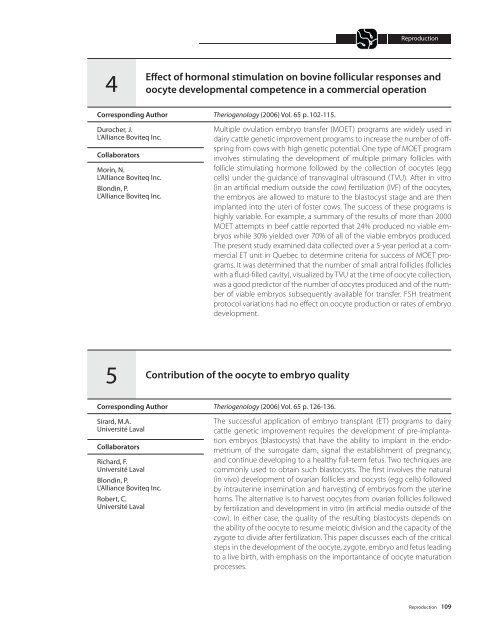A52-75-2007E.pdf - AgroMedia International Inc
A52-75-2007E.pdf - AgroMedia International Inc
A52-75-2007E.pdf - AgroMedia International Inc
Create successful ePaper yourself
Turn your PDF publications into a flip-book with our unique Google optimized e-Paper software.
Reproduction4Effect of hormonal stimulation on bovine follicular responses andoocyte developmental competence in a commercial operationCorresponding AuthorDurocher, J.L’Alliance Boviteq <strong>Inc</strong>.CollaboratorsMorin, N.L’Alliance Boviteq <strong>Inc</strong>.Blondin, P.L’Alliance Boviteq <strong>Inc</strong>.Theriogenology (2006) Vol. 65 p. 102-115.Multiple ovulation embryo transfer (MOET) programs are widely used indairy cattle genetic improvement programs to increase the number of offspringfrom cows with high genetic potential. One type of MOET programinvolves stimulating the development of multiple primary follicles withfollicle stimulating hormone followed by the collection of oocytes (eggcells) under the guidance of transvaginal ultrasound (TVU). After in vitro(in an artificial medium outside the cow) fertilization (IVF) of the oocytes,the embryos are allowed to mature to the blastocyst stage and are thenimplanted into the uteri of foster cows. The success of these programs ishighly variable. For example, a summary of the results of more than 2000MOET attempts in beef cattle reported that 24% produced no viable embryoswhile 30% yielded over 70% of all of the viable embryos produced.The present study examined data collected over a 5-year period at a commercialET unit in Quebec to determine criteria for success of MOET programs.It was determined that the number of small antral follicles (follicleswith a fluid-filled cavity), visualized by TVU at the time of oocyte collection,was a good predictor of the number of oocytes produced and of the numberof viable embryos subsequently available for transfer. FSH treatmentprotocol variations had no effect on oocyte production or rates of embryodevelopment.5Contribution of the oocyte to embryo qualityCorresponding AuthorSirard, M.A.Université LavalCollaboratorsRichard, F.Université LavalBlondin, P.L’Alliance Boviteq <strong>Inc</strong>.Robert, C.Université LavalTheriogenology (2006) Vol. 65 p. 126-136.The successful application of embryo transplant (ET) programs to dairycattle genetic improvement requires the development of pre-implantationembryos (blastocysts) that have the ability to implant in the endometriumof the surrogate dam, signal the establishment of pregnancy,and continue developing to a healthy full-term fetus. Two techniques arecommonly used to obtain such blastocysts. The first involves the natural(in vivo) development of ovarian follicles and oocysts (egg cells) followedby intrauterine insemination and harvesting of embryos from the uterinehorns. The alternative is to harvest oocytes from ovarian follicles followedby fertilization and development in vitro (in artificial media outside of thecow). In either case, the quality of the resulting blastocysts depends onthe ability of the oocyte to resume meiotic division and the capacity of thezygote to divide after fertilization. This paper discusses each of the criticalsteps in the development of the oocyte, zygote, embryo and fetus leadingto a live birth, with emphasis on the importantance of oocyte maturationprocesses.Reproduction 109





